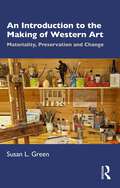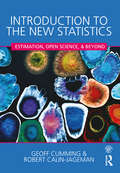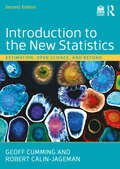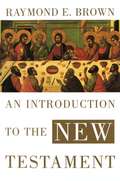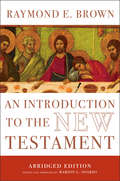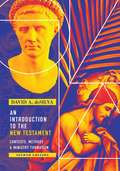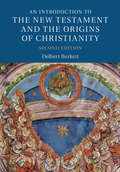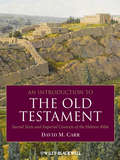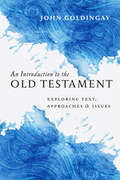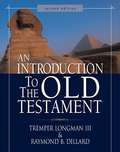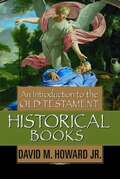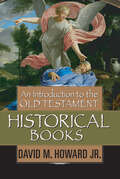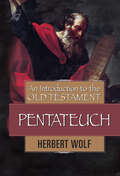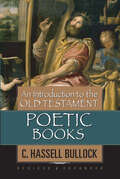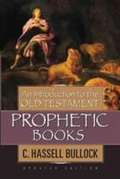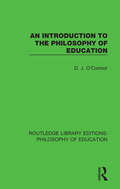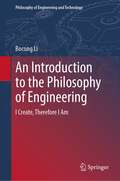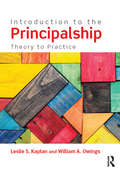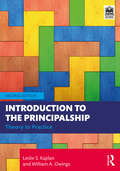- Table View
- List View
An Introduction to the Making of Western Art: Materiality, Preservation and Change
by Susan L. GreenThis book is the first introduction to Western art that not only considers how choice of materials can impact form, but also how objects in different media can alter in appearance over time, and the role of conservators in the preservation of our cultural heritage.The first four chapters cover wall and easel paintings, sculpture, drawings, and prints, from the late Middle Ages to the present day. They examine, with numerous examples, how these works have been produced, how they might have been transformed, and how efforts regarding their preservation can sometimes be misleading or result in controversy. The final two chapters look at how photography, new techniques, and modern materials prompted innovative ways of creating art in the twentieth century, and how the rapid expansion of technology in the twenty-first century has led to a revolution in how artworks are constructed and seen, generating specific challenges for collectors, curators, and conservators alike.This book is primarily directed at undergraduates interested in art history, museum studies, and conservation, but will also be of interest to a more general non-specialist audience.
Introduction to the New Statistics: Estimation, Open Science, and Beyond
by Geoff Cumming Robert Calin-JagemanThis is the first introductory statistics text to use an estimation approach from the start to help readers understand effect sizes, confidence intervals (CIs), and meta-analysis (‘the new statistics’). It is also the first text to explain the new and exciting Open Science practices, which encourage replication and enhance the trustworthiness of research. In addition, the book explains NHST fully so students can understand published research. Numerous real research examples are used throughout. The book uses today’s most effective learning strategies and promotes critical thinking, comprehension, and retention, to deepen users’ understanding of statistics and modern research methods. The free ESCI (Exploratory Software for Confidence Intervals) software makes concepts visually vivid, and provides calculation and graphing facilities. The book can be used with or without ESCI. Other highlights include: - Coverage of both estimation and NHST approaches, and how to easily translate between the two. - Some exercises use ESCI to analyze data and create graphs including CIs, for best understanding of estimation methods. -Videos of the authors describing key concepts and demonstrating use of ESCI provide an engaging learning tool for traditional or flipped classrooms. -In-chapter exercises and quizzes with related commentary allow students to learn by doing, and to monitor their progress. -End-of-chapter exercises and commentary, many using real data, give practice for using the new statistics to analyze data, as well as for applying research judgment in realistic contexts. -Don’t fool yourself tips help students avoid common errors. -Red Flags highlight the meaning of "significance" and what p values actually mean. -Chapter outlines, defined key terms, sidebars of key points, and summarized take-home messages provide a study tool at exam time. -http://www.routledge.com/cw/cumming offers for students: ESCI downloads; data sets; key term flashcards; tips for using SPSS for analyzing data; and videos. For instructors it offers: tips for teaching the new statistics and Open Science; additional homework exercises; assessment items; answer keys for homework and assessment items; and downloadable text images; and PowerPoint lecture slides. Intended for introduction to statistics, data analysis, or quantitative methods courses in psychology, education, and other social and health sciences, researchers interested in understanding the new statistics will also appreciate this book. No familiarity with introductory statistics is assumed.
Introduction to the New Statistics: Estimation, Open Science, and Beyond
by Geoff Cumming Robert Calin-JagemanThis fully revised and updated second edition is an essential introduction to inferential statistics. It is the first introductory statistics text to use an estimation approach from the start and also to explain the new and exciting Open Science practices, which encourage replication and enhance the trustworthiness of research. The estimation approach, with meta-analysis (“the new statistics”), is exactly what’s needed for Open Science.Key features of this new edition include: Even greater prominence for Open Science throughout the book. Students easily understand basic Open Science practices and are guided to use them in their own work. There is discussion of the latest developments now being widely adopted across science and medicine. Integration of new open-source esci (Estimation Statistics with Confidence Intervals) software, running in jamovi. This is ideal for the book and extends seamlessly to what’s required for more advanced courses, and also by researchers. See www.thenewstatistics.com/itns/esci/jesci/. Colorful interactive simulations, including the famous dances, to help make key statistical ideas intuitive. These are now freely available through any browser. See www.esci.thenewstatistics.com/. Coverage of both estimation and null hypothesis significance testing (NHST) approaches, with full guidance on how to translate between the two. Effective learning strategies and pedagogical features to promote critical thinking, comprehension and retention Designed for introduction to statistics, data analysis, or quantitative methods courses in psychology, education, and other social and health sciences, researchers interested in understanding Open Science and the new statistics will also appreciate this book. No familiarity with introductory statistics is assumed.A comprehensive website offers data sets, key term flashcards, learning guides, and videos describing key concepts and demonstrating the use of esci. For instructors, there are guides for teaching the new statistics and Open Science, assessment exercises, question banks, downloadable slides, and more. Altogether, the website provides engaging learning resources for traditional or flipped classrooms. See www.routledge.com/cw/cumming.
An Introduction to the New Testament: History, Literature, Theology
by M. Eugene BoringThis thoroughly researched textbook from well-respected scholar M. Eugene Boring presents a user-friendly introduction to the New Testament books. Boring approaches the New Testament as a historical document, one that requires using a hands-on, critical method. Moreover, he asserts that the New Testament is the church's book, in that it was written, selected, preserved, and transmitted by the church. Boring goes on to explore the historical foundation and formation of the New Testament within the context of pre-Christian Judaism and the world of Jesus and the early church. He then examines the individual books of the New Testament, providing helpful background information and methods for interpretation, and revealing the narrative substructure found within each of the Gospels and Letters. This volume includes helpful illustrations, charts, notes, and suggestions for further reading. Sections are laid out in a well-organized manner to help students navigate the content more easily.
An Introduction to the New Testament: History, Literature, Theology
by M. Eugene BoringThis thoroughly researched textbook from well-respected scholar M. Eugene Boring presents a user-friendly introduction to the New Testament books. Boring approaches the New Testament as a historical document, one that requires using a hands-on, critical method. Moreover, he asserts that the New Testament is the church's book, in that it was written, selected, preserved, and transmitted by the church. Boring goes on to explore the historical foundation and formation of the New Testament within the context of pre-Christian Judaism and the world of Jesus and the early church. He then examines the individual books of the New Testament, providing helpful background information and methods for interpretation, and revealing the narrative substructure found within each of the Gospels and Letters. This volume includes helpful illustrations, charts, notes, and suggestions for further reading. Sections are laid out in a well-organized manner to help students navigate the content more easily.
Introduction to the New Testament
by Raymond E. BrownEvery generation needs a comprehensive, reliable Introduction to the New Testament that opens the biblical text to the novice. Raymond E. Brown's An Introduction to the New Testament is the most trustworthy and authoritative guidebook for a generation seeking to understand the Christian Bible. Universally acknowledged as the dean of New Testament scholarship, Father Brown is a master of his discipline at the pinnacle of his career. Who else could cover the entire scope of the New Testament with such ease and clarity? This gifted communicator conveys the heartfelt concern of a beloved teacher for his students, as he walks the reader through the basic content and issues of the New Testament. While the book contains a wealth of information, its most impressive features are how the author boils down a life time of scholarship into basic summaries of each book, provides a historical overview of the ancient Greco-Roman world, engages in discussions of theological issues, and presents supplementary material for deeper understanding, such as tables, maps, bibliographies, and appendixes. Those opening to the New Testament for the first time and those seeking deeper insights could not ask for more in a primer to the Christian Bible.
An Introduction to the New Testament: The Abridged Edition
by Raymond E. Brown Marion SoardsSince its publication in 1997, Raymond Brown's Introduction to the New Testament has been widely embraced by modern readers seeking to understand the Christian Bible. Acknowledged as a paragon of New Testament studies in his lifetime, Brown was a gifted communicator who wrote with ease and clarity.  Abridged by Marion Soards, who worked with Brown on the original text, this new, concise version maintains the essence and centrist interpretation of the original without tampering with Brown's perspective, insights, or conclusions. The biblical writings themselves remain the focus, but there are also chapters dealing with the nature, origin, and interpretation of the New Testament texts, as well as chapters concerning the political, social, religious, and philosophical world of antiquity. Furthermore, augmenting Brown's commentary on the New Testament itself are topics such as the Gospels' relationship to one another; the form and function of ancient letters; Paul's thought and life, along with his motivation, legacy, and theology; a reflection on the historical Jesus; and a survey of relevant Jewish and Christian writings.  This comprehensive, reliable, and authoritative guidebook is now more accessible for novices, general readers, Bible study groups, ministers, scholars, and students alike.
An Introduction to the New Testament: Contexts, Methods and Ministry Formation
by David A DeSilvaThis New Testament introduction is different. Many introductions zero in on the historical contexts in which the New Testament literature was written. This introduction goes further--to give particular attention to the social, cultural, and rhetorical contexts of the New Testament authors and their writings. <p><p> Few introductions to the New Testament integrate instruction in exegetical and interpretive strategies with the customary considerations of authorship, dating, audience, and message. This introduction capitalizes on the opportunity, introducing students to a relevant facet of interpretation with each portion of New Testament literature. Rarely do introductions to the New Testament approach their task mindful of students preparing for ministry. This introduction is explicit in doing so, recognizing as it does that the New Testament itself--in its parts and as a whole--is a pastoral resource. <p><p> Each chapter on the New Testament literature closes with a discussion of implications for ministry formation. These integrative features alone would distinguish this introduction from others. But in addition, its pages brim with maps, photos, points of interest, and aids to learning. Separate chapters explore the historical and cultural environment of the New Testament era, the nature of the Gospels and the quest for the historical Jesus, and the life of Paul. First published in 2004, David A. deSilva's comprehensive and carefully crafted introduction to the New Testament has been long established as an authoritative textbook and resource for students.
An Introduction to the New Testament and the Origins of Christianity (Introduction to Religion)
by Delbert BurkettFirst published in 2002, this book offers an authoritative and accessible introduction to the New Testament and early Christian literature for all students of the Bible and the origins of Christianity. Delbert Burkett focuses on the New Testament, but also looks at a wealth of non-biblical writing to examine the history, religion and literature of Christianity in the years from 30 CE to 150 CE. The book is organized systematically with questions for in-class discussion and written assignments, step-by-step reading guides on individual works, special box features, charts, maps and numerous illustrations designed to facilitate student use. An appendix containing translations of primary texts allows instant access to the writings outside the canon. For this new edition, Burkett has reorganized and rewritten many chapters, and has also incorporated revisions throughout the text, bringing it up to date with current scholarship. This volume is designed for use as the primary textbook for one and two-semester courses on the New Testament and Early Christianity.
An Introduction to the New Testament and the Origins of Christianity
by Delbert BurkettThis book offers an authoritative and accessible introduction to the New Testament and early Christian literature for all students of the Bible and anyone interested in the origins of Christianity. It is designed primarily for undergraduate courses in the New Testament, biblical studies and early Christianity. There are questions for in-class discussion and written assignment, step-by-step reading guides on individual works, special box features, charts, maps and numerous illustrations designed to facilitate student use. With this textbook and the Bible, the student should therefore have all the necessary basic texts.
An Introduction to the Old Testament: Sacred Texts and Imperial Contexts of the Hebrew Bible (Journal For The Study Of The Old Testament Supplement #No. 225.)
by David M. CarrThis comprehensive, introductory textbook is unique in exploring the emergence of the Hebrew Bible in the broader context of world history. It particularly focuses on the influence of pre-Roman empires, empowering students with a richer understanding of Old Testament historiography. Provides a historical context for students learning about the development and changing interpretations of biblical texts Examines how these early stories were variously shaped by interaction with the Mesopotamian and Egyptian, Assyrian, Babylonian, Persian, and Hellenistic empires Incorporates recent research on the formation of the Pentateuch Reveals how key biblical texts came to be interpreted by Jewish, Christian, and Muslim faiths Includes numerous student-friendly features, such as study questions, review sections, bibliographies, timelines, and illustrations and photos
An Introduction to the Old Testament: Exploring Text, Approaches & Issues
by John GoldingayEnter the classroom of one of today?s premier biblical interpreters as he shares his infectious love for the Old Testament. This is where you begin the adventure of exploring the Bible?s First Testament. Some Old Testament introductions tell you what you could have seen for yourself. They might recount in detail what other scholars have said, and then tell you what you should think about it. But with refreshing directness, John Goldingay outfits you with basic knowledge, points out the main approaches, outlines the primary issues and then sets you loose to explore the terrain for yourself. Traverse the grand tapestry of the Torah. Discern the art and grain of biblical narrative. Listen to the cries, confessions and cadences of the Psalms. Probe the varied textures of wisdom literature. And ponder the prophets in the darkening nightmare of exile and the distant light of hope. More workbook than handbook, this introduction to the Old Testament is rooted in decades of tried and proven teaching. Goldingay displays a robust confidence in the truthfulness of Scripture combined with a refreshing trust in the reader's ability to grapple responsibly with the Old Testament. Even when the text hits you sideways, Goldingay encourages you not to squirm or run, but to grab hold and go deeper. Under his expert guidance the cordon between faith and criticism swings open into theological and spiritual insight.
An Introduction to the Old Testament: Second Edition
by Tremper Longman IIIAn upper-level introduction to the Old Testament that offers students a thorough understanding of three key issues: historical background, literary analysis, and theological message.This second edition of An Introduction to the Old Testament integrates recent developments in Old Testament scholarship. It has many distinctive features that set it apart from other introductions to the Old Testament:It's committed to a theologically evangelical perspective.Emphasizes "special introduction"—the study of individual books.Interacts in an irenic spirit with the historical-critical method.Features points of research history and representative scholars rather than an exhaustive treatment of past scholarship.Deals with the meaning of each book, not in isolation but in a canonical context.Probes the meaning of each book in the setting of its culture.Including callouts, charts, and graphs, An Introduction to the Old Testament is written with an eye to understanding the nature of Old Testament historiography.Perfect for seminary students, professors, and Bible teachers and ministry leaders, as well as anyone looking for an in-depth and balanced approach to Old Testament study.
An Introduction to the Old Testament Historical Books
by David M. HowardRich rewards await readers who dig deep into the historical books of the Old Testament. Incredible events, amazing love stories, larger-than-life personalities, and deep theological themes are just some of the treasures found in Joshua, Judges, Ruth, 1 and 2 Samuel, 1 and 2 Kings, 1 and 2 Chronicles, Ezra, Nehemiah, Esther. <p><p> These books tell the story of the nation of Israel and the God who loves her, punishes her, and always brings this recalcitrant people back to Himself. It is really the story of all of us. <p><p> David M. Howard Jr. provides an in-depth introduction to the Old Testament historical books, focusing first on the overarching themes of historical narrative in general. He then turns his attention to each book, considering topics like: <p>• Authorship and date <p>• Place in the canon <p>• Historical and cultural context <p>• Theology of the book <p>• Special issues pertaining to the book <p><p> From the conquest of Canaan to the fall of Jerusalem, from war to peace and back to war, from kings and queens to farmers and housewives—David Howard covers it all in this invaluable introduction to the Old Testament historical books.
An Introduction to the Old Testament Historical Books
by David M. Howard Jr.Rich rewards await readers who dig deep into the historical books of the Old Testament. Incredible events, amazing love stories, larger-than-life personalities and deep theological implications and themes are just part of the t treasure that awaits readers of Joshua, Judges, Ruth, 1 & 2 Samuel, 1 & 2 Kings, 1 & 2 Chronicles, Ezra, Nehemiah, Esther.These books tell the story of the nation of Israel and the God who loves her, punishes her, and always brings this recalcitrant people back to Himself. It is really the story of all of us.David M. Howard Jr. provides an in-depth introduction to the Old Testament historical books, focusing first on the overarching themes of historical narrative in general. He then turns his attention to each book.From the conquest of Canaan to the fall of Jerusalem, from war to peace and back to war, from kings and queens to farmers and housewives--David Howard covers it all in this invaluable introduction to the Old Testament historical books.
An Introduction to the Old Testament Historical Books
by David M. Howard Jr.Rich rewards await readers who dig deep into the historical books of the Old Testament. Incredible events, amazing love stories, larger-than-life personalities and deep theological implications and themes are just part of the t treasure that awaits readers of Joshua, Judges, Ruth, 1 & 2 Samuel, 1 & 2 Kings, 1 & 2 Chronicles, Ezra, Nehemiah, Esther.These books tell the story of the nation of Israel and the God who loves her, punishes her, and always brings this recalcitrant people back to Himself. It is really the story of all of us.David M. Howard Jr. provides an in-depth introduction to the Old Testament historical books, focusing first on the overarching themes of historical narrative in general. He then turns his attention to each book.From the conquest of Canaan to the fall of Jerusalem, from war to peace and back to war, from kings and queens to farmers and housewives--David Howard covers it all in this invaluable introduction to the Old Testament historical books.
An Introduction to the Old Testament Pentateuch
by Herbert WolfThe Pentateuch--Genesis, Exodus, Leviticus, Numbers, Deuteronomy--are the vital first books in the Bible. understanding the scope, meaning, and events of these five books is integral to understanding the whole of Scripture that follows.Old Testament expert Herbert Wolf provides layreaders and scholars alike with a strong undergirding of understanding and knowledge in this introduction that reveals both the seriousness and excitement of the Pentateuch. Readers will find Adam, Abraham, Joseph, Moses and Joshua in these pages, as well as terrible sin and glorious forgiveness, bloody sacrifices and battles, deadly betrayal and life-giving hope.Wolf first addresses the overarching themes that flow through the Pentateuch, with special attention given to Moses as author of the five books. He then addresses each book specifically, covering topics such as purpose and scope, and literary structure. He tailors additional study to each specific book. This book contributes significantly to a clear, deep understanding of the Bible's first five books.
An Introduction to the Old Testament Pentateuch
by Herbert WolfThe Pentateuch--Genesis, Exodus, Leviticus, Numbers, Deuteronomy--are the vital first books in the Bible. understanding the scope, meaning, and events of these five books is integral to understanding the whole of Scripture that follows.Old Testament expert Herbert Wolf provides layreaders and scholars alike with a strong undergirding of understanding and knowledge in this introduction that reveals both the seriousness and excitement of the Pentateuch. Readers will find Adam, Abraham, Joseph, Moses and Joshua in these pages, as well as terrible sin and glorious forgiveness, bloody sacrifices and battles, deadly betrayal and life-giving hope.Wolf first addresses the overarching themes that flow through the Pentateuch, with special attention given to Moses as author of the five books. He then addresses each book specifically, covering topics such as purpose and scope, and literary structure. He tailors additional study to each specific book. This book contributes significantly to a clear, deep understanding of the Bible's first five books.
An Introduction to the Old Testament Poetic Books
by C. Hassell BullockThe poetic books of the Old Testament--Job, Psalms, Proverbs, Ecclesiastes, Song of Solomon--are often called humankind's reach toward God. The other books of the Old Testament picture God's reach toward man through the redemptive story. Yet these five books reveal the very hear of men and women struggling with monumental issues such as suffering, sin, forgiveness, joy, worship, and the passionate love between a man and woman.C. Hassell Bullock, a noted Old Testament scholar, delves deep into the hearts of the five poetic books, offering readers helpful details such as harmeneutical considerations for each book, theological content and themes, detailed analysis of each book, and cultural perspectives.Hebrew is a language of "intrinsic musical quality that naturally supports poetic expression," says Bullock in his introduction. That poetic expression comes from the heart of the Old Testament writers and reaches all of us exactly where we are in our own struggles and joys.
An Introduction to the Old Testament Poetic Books
by C. Hassell BullockThe poetic books of the Old Testament--Job, Psalms, Proverbs, Ecclesiastes, Song of Solomon--are often called humankind's reach toward God. The other books of the Old Testament picture God's reach toward man through the redemptive story. Yet these five books reveal the very hear of men and women struggling with monumental issues such as suffering, sin, forgiveness, joy, worship, and the passionate love between a man and woman.C. Hassell Bullock, a noted Old Testament scholar, delves deep into the hearts of the five poetic books, offering readers helpful details such as harmeneutical considerations for each book, theological content and themes, detailed analysis of each book, and cultural perspectives.Hebrew is a language of "intrinsic musical quality that naturally supports poetic expression," says Bullock in his introduction. That poetic expression comes from the heart of the Old Testament writers and reaches all of us exactly where we are in our own struggles and joys.
An Introduction to the Old Testament Prophetic Books
by C. Hassell BullockThe Old Testament prophets spoke to Israel in times of historical and moral crisis. They saw themselves as being a part of a story that God was weaving throughout history--a story of repentance, encouragement, and a coming Messiah. In this updated introductory book, each major and minor prophet and his writing are clustered with the major historical events of their time. Our generational distance from the age of the prophets might seem to be a measureless chasm. Yet we dare not make the mistake of assuming that passing years have rendered irrelevant not only the Old Testament prophets, but also the God who comprehends, spans, and transcends all time. In these pages, C. Hassell Bullock presents a clear picture of some of history's most profound spokesmen--the Old Testament prophets--and the God who shaped them.
An Introduction to the Philosophy of Education (Routledge Library Editions: Philosophy of Education #14)
by D. J. O'ConnorEducation, like every other important branch of knowledge, has its underlying philosophical problems. It is these problems and the attempts to solve them which together make up the philosophy of education. This book, first published in 1957, provides a simple explanation and illustration of what philosophy can (and cannot) do for educational thinking. This title will be of interest to students of the philosophy of education.
An Introduction to the Philosophy of Engineering: I Create, Therefore I Am (Philosophy of Engineering and Technology #39)
by Bocong LiThis book is the first academic work on the philosophy of engineering in China that reflects two decades of research. It puts forward a new thesis, namely that the core maxim in the philosophy of engineering is “I create, therefore I am,” which is radically different from the Cartesian maxim: “I think, therefore I am.” In addition, the book offers the first detailed portrait of the roots and evolution of the philosophy of engineering in China. The book begins by discussing the triptych thesis of science, technology and engineering, which argues that there are a number of important distinctions between the three, e.g. scientific activities are chiefly based on discovery, while technological activities center on invention, and engineering activities focus on creation. Considering the latest developments in the philosophy of engineering, the author also analyzes engineering communities, engineering practice and a micro–meso–macro framework. In subsequent chapters, the author separately analyzes the three stages of engineering activities: planning, operating and using artifacts. In the closing chapter, two views on the philosophy of engineering (as a new subdiscipline of philosophy and as a philosophy in its own right) are briefly explained.
Introduction to the Principalship: Theory to Practice
by Leslie S. Kaplan William A. OwingsThe latest leadership textbook from respected author team Kaplan and Owings explores how principals can effectively build a culture around student achievement. Introduction to the Principalship helps aspiring principals understand how to develop a vision for improvement, make decisions and manage conflict, build teachers’ capacity, communicate, monitor the organization’s performance, and create a school climate of mutual respect. This important book provides readers with various leadership concepts to inform their practice, as well as the cognitive and practical tools to evaluate and prioritize what leadership actions to take. Each chapter offers opportunities for readers to create personal meaning and explore new ways of doing leadership to advance a positive, person-focused environment. Providing both the theoretical framework and skills for effective practice, Introduction to the Principalship addresses the issues most urgent and relevant for educational leadership graduate students learning how to build a school culture that promotes every student’s success. Special Features: • Learning Objectives—chapter openers introduce the topic and initiate student thinking.• Reflections and Relevance —interactive exercises, role plays, class activities, and assignments help readers think about content in personally meaningful ways, facilitate understanding of chapter content, and help transfer leadership thinking to action in their own schools.• ISLLC Standards—each chapter is aligned to the 2015 Interstate School Leadership Licensure Standards.• Companion Website—includes links to supplemental material, additional readings, and PowerPoints for instructors.
Introduction to the Principalship: Theory to Practice
by Leslie S. Kaplan William A. OwingsThe second edition of this textbook from respected author team Kaplan and Owings explores how principals can effectively build a culture around student achievement. Introduction to the Principalship, a second edition closely aligned with NELP (2018) standards, helps aspiring principals understand how to develop a vision for improvement, make decisions and manage conflict, build teachers’ capacity, communicate, monitor the organization’s performance, and create a school climate of mutual respect. This important book provides readers with various leadership concepts to inform their practice, as well as the cognitive and practical tools to evaluate and prioritize what leadership actions to take. Each chapter offers opportunities for readers to create personal meaning and explore new ways of doing leadership to advance a positive, person-focused environment. Providing both the theoretical framework and skills for effective practice, Introduction to the Principalship addresses the issues most urgent and relevant for educational leadership graduate students learning how to build a school culture that promotes every student’s success. Fully revised, this second edition includes a new chapter on building your capacity for leadership, expanded discussion of data-informed accountability, equity considerations, and crisis management, and all chapters updated and revised throughout to reflect the latest developments in the field. Special Features: •Learning Objectives—chapter openers introduce the topic and initiate student thinking. •Reflections and Relevance—interactive exercises, role plays, class activities, and assignments that can be used synchronously and asynchronously to deepen and extend student learning. •Key Takeaways—organized by learning objective, these answer readers’ question, "What about this information is meaningful for me as an aspiring principal?" •Suggested Readings—each chapter concludes with annotated suggested readings to extend and deepen discussion of key issues in chapter. •NELP Standards—each chapter is aligned to the latest school leadership licensure standards. •Companion Website—includes links to supplemental material, additional readings, video clips with related teaching and learning activities, and PowerPoints for instructors.
